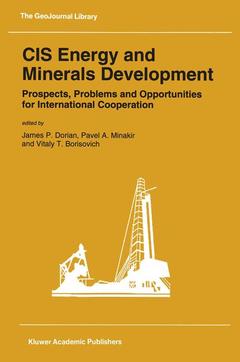Description
CIS Energy and Minerals Development, Softcover reprint of the original 1st ed. 1993
Prospects, Problems and Opportunities for International Cooperation
GeoJournal Library Series, Vol. 25
Coordinators: Dorian J.P., Minakir Pavel A., Borisovich Vitaly T.
Language: English
Subjects for CIS Energy and Minerals Development:
Keywords
East Asia; Nation; development; mining; production; economic geology
Publication date: 10-2012
368 p. · 16x24 cm · Paperback
368 p. · 16x24 cm · Paperback
Description
/li>Contents
/li>Biography
/li>
The former Soviet Union possessed some of the world's largest reserves of energy and mineral resources. With the dissolution of the country in 1991, the former Soviet republics are now exercising complete control over their mining industries. The new Commonwealth of Independent States (CIS) consists of several new nations, well-endowed in hydrocarbons, metals, and industrial materials; efforts are now underway to boost development activities and attract foreign investment. Commonwealth members today are implementing policies to regulate energy and mineral development and enhance economic growth.
This book provides a comprehensive overview of the energy and minerals industries of the CIS and other former Soviet republics outside the Commonwealth. Prospects for international cooperation and trade in hydrocarbons, metals, and nonmetals are examined, as are opportunities for joint ventures and technology transfers in mining. Economic relations between the CIS and several Asian nations are also analyzed. Contributors to the book from throughout the Commonwealth, Asia, Europe, and North America have a wide variety of backgrounds in the energy and mineral fields, including government, academia, and industry.
This book provides a comprehensive overview of the energy and minerals industries of the CIS and other former Soviet republics outside the Commonwealth. Prospects for international cooperation and trade in hydrocarbons, metals, and nonmetals are examined, as are opportunities for joint ventures and technology transfers in mining. Economic relations between the CIS and several Asian nations are also analyzed. Contributors to the book from throughout the Commonwealth, Asia, Europe, and North America have a wide variety of backgrounds in the energy and mineral fields, including government, academia, and industry.
1. Introduction and Background: A New Beginning.- One: Commonwealth Mining Industry.- 2. Energy and Fuel Resources in the Commonwealth of Independent States: Major Developments and Prospects.- 3. Commonwealth Mineral Resources and Economic Development.- 4. Joint Mining Ventures in the Former Soviet Union: A Focus on the Russian Federation.- 5. New Perspectives on an Old Gold Mining Country.- 6. Opportunities for Technology Transfer Between the United States and the Commonwealth of Independent States: A Focus on the Mining Sector.- Two: Regional Issues and Affairs.- 7. Development of the Armenian Mining Industry: Rational Exploitation and Use of Joint Ventures.- 8. Kazakhstan’s Mineral Raw Materials Industry and Its Potential.- 9. Geology, Mineral Resources and the Mineral Development Potential of the Russian Far East.- 10. Energy Supplies of the Russian Far East: Prospects for Using Natural Gas and Nuclear Power.- 11. Mineral Resources of the Far East: Prospects for Export.- 12. The Russian Far East: Economic Conditions and Prospects for Cooperation in Northeast Asia.- Three: International Trade and Relations.- 13. Issues Affecting Northeast Asian Minerals and Energy Markets.- 14. Exploration and Mining Conditions in the Asia-Pacific Region: An Industry Perspective.- 15. Soviet Asia-Pacific Minerals Trade: Past Performance and Future Outlook.- 16. Multilateral Energy Cooperation in Northeast Asia: A Focus on Oil and Natural Gas Development.- 17. Australia-Commonwealth Ties in the Minerals Sector.- 18. Prospects for Sino-CIS Cooperation in Nonferrous Metals.- 19. Evolving Commonwealth-Japan Economic Relations.- 20. The New Zealand-Soviet Union/CIS Economic Relationship: Problems and Prospects in a Time of Change.- Appendix A: Mineral Production Statistics of the FormerSoviet Union.
James P. Dorian is a Research Associate with the Program on Resources: Energy and Minerals at the East-West Center and Affiliate Graduate Faculty at the University of Hawaii. Pavel A. Minakir is Director of the Institute of Economics Research in Khabarovsk and Vice Governor of Khabarovsk Territory. Vitaly T. Borisovich is Head of the Department of Economics at the Moscow Geological and Prospecting Institute.
© 2024 LAVOISIER S.A.S.




